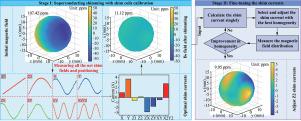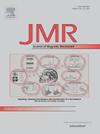在 7 T 无低温小型动物磁共振成像磁体上实施两阶段、垫片场校准超导垫片法。
IF 2
3区 化学
Q3 BIOCHEMICAL RESEARCH METHODS
引用次数: 0
摘要
与低磁场系统相比,超高磁场系统(≥ 7 T)可提高磁共振成像(MRI)的信噪比,改善成像性能。然而,这些改进在很大程度上依赖于高 B0 磁场均匀性水平,而这可以通过超导垫片来实现。本文介绍了一种新颖的两阶段超导垫片方法,旨在实现 7 T MRI 超导磁体的精确垫片。在初始阶段,进行了详细的测量和装配,以确定电流极性和垫片磁场的轴向或圆周位置。随后,实施了优化策略,以确定具有灵活目标磁场的最佳垫片电流。第二阶段包括一个迭代过程,对特定垫片线圈的电流进行微调,确定其对磁场均匀性的影响最大。总体合格率为 99.5%,凸显了确定电流极性和垫片场位置的精确性。值得注意的是,经过校准的垫片系统极大地改善了峰峰值和均方根误差(RMSE)场均匀性,分别从 107.42 ppm 和 37.00 ppm 降至 11.12 ppm 和 3.26 ppm,即分别改善了 89.65% 和 91.19%。此外,微调阶段的模拟结果表明,通过将 Z2 垫片线圈的电流降低 51.3 mA,峰-峰场均匀性进一步提高到 9.9 ppm。此外,微调后的磁场具有很高的时间稳定性,在 48 小时内观察到的最大变化仅为 27 µT。因此,所提出的两阶段超导微调框架有效地解决了 B0 磁场不完美的难题,提高了峰峰值和均方根值磁场的均匀性。分步优化方法还能减轻垫片间耦合造成的偏差,证明了它在超高场磁共振成像系统中实现精确垫片的功效。本文章由计算机程序翻译,如有差异,请以英文原文为准。

Implementing a two-stage, shim field-calibrated superconducting shimming method on a 7 T cryogen-free small animal MRI magnet
Ultrahigh field systems ( 7 T) can increase the signal-to-noise ratio of magnetic resonance imaging (MRI), improving imaging performance compared to systems with lower fields. However, these enhancements heavily rely on a high magnetic field homogeneity level, which can be achieved through superconducting shimming. This paper presents a novel two-stage superconducting shimming method designed to achieve precise shimming for a 7 T MRI superconducting magnet. In the initial stage, detailed measurements and fittings were conducted to determine the current polarity and the axial or circumferential positions of the shim fields. Subsequently, an optimization strategy was implemented to determine the optimal shim currents with a flexible target field. The second stage involves an iterative process to fine-tune the current of a specific shim coil, identified as having the most significant impact on field homogeneity. The overall fitness of 99.5% underscores the precision in determining the current polarity and position of the shim fields. Significantly, the calibrated shim system substantially improves the peak-to-peak and Root Mean Square Error (RMSE) field homogeneities from 107.42 ppm and 37.00 ppm to 11.12 ppm and 3.26 ppm, respectively, representing improvements of 89.65% and 91.19%. Furthermore, the simulation results of the fine-tuning stage demonstrate additional enhancements in peak-to-peak field homogeneity, to 9.9 ppm by reducing the current of the Z2 shim coil by 51.3 mA. Additionally, the shimmed magnetic field exhibited high time stability, with a maximum variation of only 27 observed within 48 h. Thus, the proposed two-stage superconducting shimming framework effectively addresses the challenge of imperfect magnetic fields, enhancing peak-to-peak and RMSE field homogeneity. The stepwise optimized approach also mitigates deviations caused by shim-to-shim coupling, demonstrating its efficacy in achieving precise shimming in ultrahigh-field MRI systems.
求助全文
通过发布文献求助,成功后即可免费获取论文全文。
去求助
来源期刊
CiteScore
3.80
自引率
13.60%
发文量
150
审稿时长
69 days
期刊介绍:
The Journal of Magnetic Resonance presents original technical and scientific papers in all aspects of magnetic resonance, including nuclear magnetic resonance spectroscopy (NMR) of solids and liquids, electron spin/paramagnetic resonance (EPR), in vivo magnetic resonance imaging (MRI) and spectroscopy (MRS), nuclear quadrupole resonance (NQR) and magnetic resonance phenomena at nearly zero fields or in combination with optics. The Journal''s main aims include deepening the physical principles underlying all these spectroscopies, publishing significant theoretical and experimental results leading to spectral and spatial progress in these areas, and opening new MR-based applications in chemistry, biology and medicine. The Journal also seeks descriptions of novel apparatuses, new experimental protocols, and new procedures of data analysis and interpretation - including computational and quantum-mechanical methods - capable of advancing MR spectroscopy and imaging.

 求助内容:
求助内容: 应助结果提醒方式:
应助结果提醒方式:


